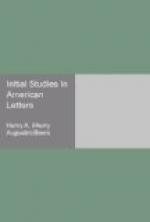The greatest, on the whole, of American historians was John Lothrop Motley (1814-77), who, like Bancroft, was a student at Goettingen and United States minister to England. His Rise of the Dutch Republic, 1856, and History of the United Netherlands, published in installments from 1861 to 1868, equaled Bancroft’s work in scientific thoroughness and philosophic grasp, and Prescott’s in the picturesque brilliancy of the narrative, while it excelled them both in its masterly analysis of great historic characters, reminding the reader, in this particular, of Macaulay’s figure-painting. The episodes of the siege of Antwerp and the sack of the cathedral, and of the defeat and wreck of the Spanish Armada, are as graphic as Prescott’s famous description of Cortez’s capture of the city of Mexico; while the elder historian has nothing to compare with Motley’s vivid personal sketches of Queen Elizabeth, Philip the Second, Henry of Navarre, and William the Silent. The Life of John of Barneveld, 1874, completed this series of studies upon the history of the Netherlands, a theme to which Motley was attracted because the heroic struggle of the Dutch for liberty offered, in some respects, a parallel to the growth of political independence in Anglo-Saxon communities, and especially in his own America.
The last of these Massachusetts historical writers whom we shall mention is Francis Parkman (1823- ), whose subject has the advantage of being thoroughly American. His Oregon Trail, 1847, a series of sketches of prairie and Rocky Mountain life, originally contributed to the Knickerbocker Magazine, displays his early interest in the American Indians. In 1851 appeared his first historical work, the Conspiracy of Pontiac. This has been followed by the series entitled France and England in North America, the six successive parts of which are as follows: the Pioneers of France in the New World, the Jesuits in North America; La Salle and the Discovery of the Great West; the Old Regime in Canada; Count Frontenac and New France; and Montcalm and Wolfe. These narratives have a wonderful vividness, and a romantic interest not inferior to Cooper’s novels. Parkman made himself personally familiar with the scenes which he described, and some of the best descriptions of American woods and waters are to be found in his histories. If any fault is to be found with his books, indeed, it is that their picturesqueness and “fine writing” are a little in excess.
The political literature of the years from 1837 to 1861 hinged upon the antislavery struggle. In this “irrepressible conflict” Massachusetts led the van. Garrison had written in his Liberator, in 1830, “I will be as harsh as truth and as uncompromising as justice. I am in earnest; I will not equivocate; I will not excuse; I will not retreat a single inch; and I will be heard.” But the Garrisonian abolitionists remained for a




